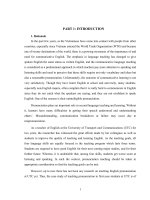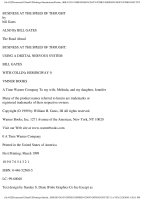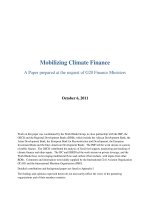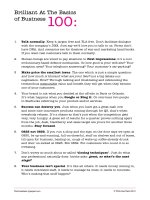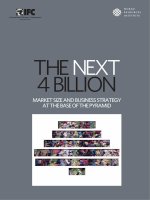Trade secrets at the market of Forex_1 pptx
Bạn đang xem bản rút gọn của tài liệu. Xem và tải ngay bản đầy đủ của tài liệu tại đây (165.62 KB, 14 trang )
1
If you have traveled internationally, you probably are well aware of
the foreign exchange market, often called the forex or FX market.
When you converted U.S. dollars into euros or yen or vice versa at a
bank or currency exchange, you may have noticed big differences in
the buying power of your currency, depending on when and where you
you made the transactions. Although you may have noted the impact
on your pocketbook, you may not have realized that you were also
participating in the largest market in the world.
The forex market trades an estimated $1.5 to $2.5 trillion a day. No
one really knows what the actual figure is because there is no central
marketplace for keeping tabs on all of the forex transactions around
the world. The forex market is massive, dwarfing the $30 billion a day
traded at the New York Stock Exchange. In fact, forex trading exceeds
the combined volume of all the major exchanges trading equities,
futures, and other instruments around the globe.
Although professional traders implementing sophisticated strategies
account for most of the trading in the huge forex market, participation
by individual traders has grown tremendously in recent years with
the proliferation of the Internet, enhancements in personal comput-
WHAT IS
FOREX?
1
TRADE SECRETS
2
ers and trading software, the launch of dozens of cash forex firms
taking advantage of online trading, and the globalization of markets
in general. The introduction of the euro on January 1, 1999, and the
weakness of the U.S. dollar after peaking in 2001 also contributed to
the surge of interest in forex trading. Increased numbers of individual
traders became aware of the role of forex in global markets with an eye
toward profiting as currency trends unfolded.
More international trade, reduced government regulation, expansion
of democracy worldwide, the increase in private ownership and free
enterprise concepts, and a greater acceptance of free-market trading
principles should keep the forex market at the forefront of traders’
attention for many years to come.
LOCAL VALUES, INTERNATIONAL IMPACT
Every country has its own currency to facilitate its business and trade.
The value of one currency as compared to another depends on the eco-
nomic health of the nations involved as well as the perception of stabil-
ity and confidence in the political climate in those countries. As con-
ditions change, currency values fluctuate to reflect the new situation.
These fluctuations create challenges for corporate financial officers and
institutional fund managers but also provide opportunities for traders
who want to speculate on impending changes in currency values.
Changes in currency valuations have a significant impact on govern-
ments, corporations, and financial institutions. Currency fluctuations,
particularly when they are abrupt, affect the performance of bottom
lines and the prices for many commodities and other markets. The
forex market probably has a more pervasive influence on worldwide
economic conditions than any other market, including crude oil.
By their very nature, currencies entail strong intermarket relation-
ships. It is obvious that a currency cannot trade in isolation and that
3
FOREX TRADING USING INTERMARKET ANALYSIS
the mass psychology that drives changes in the value of one currency
is bound to have an influence on what happens to other currencies as
well as other related markets. Because government policies and eco-
nomic developments that affect currency values tend to evolve over
time, currencies are good trending markets.
The key to successful forex trading is understanding how these cur-
rency markets relate to each other and how patterns of past price
action can be expected to occur in the future as markets respond to
ongoing financial, political, and economic forces. However, these pat-
terns and trends are elusive and may not be obvious from the examina-
tion of price charts. Nevertheless, traders need to spot these patterns
and trends early, to get into what are potentially highly profitable
trades and to avoid others.
Clearly, intermarket analysis tools that can help traders spot these
recurring patterns and trends in their early stages can give traders
a broad perspective and a competitive edge in today’s fast-paced
forex trading arena. It was this realization more than twenty years ago
that led to my focus on intermarket analysis and the development of
intermarket-based market forecasting tools that could discern likely
short-term trend changes based on the pattern recognition capabilities
of neural networks when applied properly to intermarket data. The
forex market, by its very nature, is an ideal trading vehicle for the
intermarket analysis and trend-forecasting approaches explained in
this book.
WHY TRADE FOREX?
The first question you may have is, “Why trade forex? Is not forex
something that interests only bankers and big money managers?” The
advantages of trading forex are explained in detail in Chapter 2. The
TRADE SECRETS
4
characteristics of forex trading are described in this chapter, which
should convince traders to include forex in their trading portfolios.
CHARACTERISTICS OF FOREX TRADING
Diversification. We live in a world where terrorist attacks can occur
at any time and place; where geopolitical tensions over nuclear power,
oil, human rights, and many other issues threaten to disrupt normal
trade and economic relationships; where U.S. companies are investing
heavily in China and elsewhere to reduce their labor costs; and where
China, in turn, is trying to invest in U.S. companies. Economic uncer-
tainty seems to be a way of life. Traders cannot express their investment
concerns about these issues, whether for protection or speculation, in
any individual nation’s stock or interest rate markets. Forex is the
only instrument that incorporates all of these areas of potential con-
cern and serves as a distinct asset class for speculators and investors.
Global Market. Markets such as equities or interest rates tend to
be traded locally during the business day in their own time zone. For
example, Japanese traders focus on Japanese stocks, European trad-
ers on European stocks, and U.S. traders on U.S. stocks. All of these
traders certainly should be aware of what is happening elsewhere as
the global integration of financial markets continues. However, an
event in Japan that directly affects Japanese stocks may not have the
same effect in Europe, and traders of European stocks may not pay as
close attention to what happens in the Japanese or U.S. stock markets.
Forex, on the other hand, is an asset class that is truly a global invest-
ment reflecting every economic development on earth. Whatever has
an influence on currencies in Japan has an effect on what happens to
currencies in London or Chicago. It is clear that intermarket relation-
ships among currencies are extremely important in today’s world.
5
FOREX TRADING USING INTERMARKET ANALYSIS
Twenty-four-hour Trading. Forex trading begins Monday morning
in Sydney, Australia (Sunday afternoon in the United States) and
moves around the globe as business days begin in financial centers
from Tokyo to London to New York, ending with the close of trad-
ing Friday afternoon in New York. Anything that happens anywhere
in the world at any time of day or night affects the forex market
immediately. It is not necessary for an exchange to open before the
effects can be seen. The forex market is always open for trading.
Electronic Trading. With the advances of technology, specifically,
the Internet and online trading, and electronic trade-matching plat-
forms, most forex trade executions are instantaneous, getting traders
into and out of positions with the click of a mouse once they make a
trading decision. All of the benefits of electronic trading and updates
of positions and current status are available to today’s forex trader.
Liquidity. With the size of the forex market, around-the-clock trading,
and electronic trade execution, illiquidity is not much of an issue in most
venues of forex trading. There is almost always someone to take the other
side of a position a trader may want to establish, no matter when the order
is placed. Forex bids and asks tend to be tight and slippage minimal.
Leverage. Forex markets provide some of the highest leverage of
any investment vehicle. Traders may put up only a few hundred dol-
lars to control a sizable position worth $100,000. As a result, a small
move in a trader’s favor can produce a big return on an investment.
However, traders must remember that leverage works both ways. A
small move that is against a position can eat up the money in trad-
ers’ accounts quickly if they are not nimble traders who take quick
action to cut losses. What leverage gives, it can also take away.
Plenty of Information. Governments issue dozens of reports every
month that influence the forex market (see Chapter 3). Information is
widely disseminated by the financial media. With advances in the Internet
TRADE SECRETS
6
and financial news services, prices and economic data are delivered
within moments of being released and are available to all forex traders
throughout the world. If anything, there may be too much information
for traders to sort through, which has its own negative consequences.
Simplicity. Traders do not have to watch or analyze the reports
and price movements of hundreds of companies or mutual funds,
trying to figure out which to buy or sell. With all of the funda-
mental information coming from many sources every day, traders
can make trading life easier by concentrating on the forex market
because they can easily limit themselves to monitoring movements
of a half-dozen forex pairs. In addition, traders do not have to worry
about going short or selling on a downtick as they do with equi-
ties because it is as easy to sell as it is to buy in the forex market.
Good Technical Market. Once traders understand the basics of
technical analysis and how they can apply a software program to
trading, they can extend that knowledge to all forex markets with-
out having to learn and understand a whole new set of market fac-
tors. Because currencies are influenced by government policies
and economic developments that usually stretch over long periods
of time, forex markets have a reputation for being good trending
markets. As a result, if traders keep an eye on economic condi-
tions and charts as they evolve, they may find that forex market
moves are easier to predict than are movements in other markets. A
glance at a currency chart such as the Canadian dollar is enough to
show clear long-term trends (Figure 1.1), which often have enough
movement within them to satisfy the trader looking for short-term
swing moves, as indicated by the bold-face bars in Figure 1.2.
Active Price Movement. Whether looking at price movements within
a day or over a number of days, currencies tend to have trading ranges
that are wide enough to produce attractive trading opportunities.
7
FOREX TRADING USING INTERMARKET ANALYSIS
Fi g u r e 1.1.
Source: VantagePoint Intermarket Analysis Software (www.TraderTech.com)
CurrenCies tend to have good long-term trends. the Canadian dollar
Chart illustrates the trending nature of CurrenCies.
Source: VantagePoint Intermarket Analysis Software (www.TraderTech.com)
CurrenCies also have good short-term moves. although CurrenCies
often have extended trends, the same Canadian dollar Chart in figure
1.1 shows they also tend to have tradable Counter trends that appeal
to the aCtive trader who moves into and out of positions.
Fi g u r e 1.2.
TRADE SECRETS
8
Volatility is necessary for a trader to make money in any market, and
the forex market usually provides more than enough volatility because
there are new developments that affect the forex market every day.
Not Too Volatile. Forex markets can have abrupt price movements,
but as a 24-hour market where price changes are always flowing
through the system, forex markets rarely make the type of price move
seen in stocks or futures. Stocks can plunge or soar 10 percent or more
on some overnight earnings report or other announcement, leaving
gaps on price charts when an exchange opens. A $3 change on a $30
stock is not that unusual, but a 10 percent move in a currency—for
example, 12 cents if the euro were at $1.20—is quite unlikely.
In addition, while emerging markets may incur some extreme currency
price movements, the major currencies are not like Enron, Worldcom,
or dotcom stocks that fly all over the chart or even plummet and, like
Refco, declare bankruptcy. If forex trading appears too volatile and
risky, it may be a pleasant surprise for traders to learn that the forex
market is probably more stable than the equities markets.
PAIRS, PIPS AND POINTS
Forex trading involves the simultaneous buying of one currency and
the selling of another. Unlike markets such as soybeans or Treasury
notes where traders are either long or short the market when they enter
an outright position, forex traders are always trading pairs of curren-
cies—that is, they are always long one currency and short another.
Forex trades are expressed in terms of the first currency of the pair.
For example, a U.S. dollar/Japanese yen position—USD/JPY to the
forex trader—means you are long the dollar and short the yen, believ-
ing the value of dollar will gain relative to the value of the yen.
9
FOREX TRADING USING INTERMARKET ANALYSIS
The U.S. dollar is the key currency in many of these pairs. Together
with the U.S. dollar, six other major currencies account for more than
90 percent of all forex transactions. These are the Japanese yen, euro,
British pound, Swiss franc, Canadian dollar, and Australian dollar.
The Mexican peso, Thailand baht, and dozens of other currencies
are also traded in the forex market, and some have periods of active
trading caused by extraordinary circumstances. For the most part,
however, the forex trader can concentrate on just six major currency
pairs that have the most liquidity:
• Euro/U.S.dollar(EUR/USD)
• U.S.dollar/Japaneseyen(USD/JPY)
• Britishpound/U.S.dollar(GBP/USD)
• U.S.dollar/Swissfranc(USD/CHF)
• U.S.dollar/Canadiandollar(USD/CAD)
• U.S.dollar/Australiandollar(USD/AUD)
When currencies other than the U.S. dollar are traded against each
other—for example, the Japanese yen against the euro (JPY/EUR)—
these positions are known as cross-rates.
The first currency of a pair is the base currency; this is the main
unit that traders buy or sell. The second currency is the secondary
or counter currency against which they trade the base currency. The
base currency has a value of 1.0, and the second currency is quoted
as the number of units against the base currency. In the EUR/USD
pair, you are looking at the number of dollars per one euro, the base
currency—for example, 1.2000 dollars for each euro. In the USD/
JPY pair, you are looking at the number of yen per dollar, the base
currency—for example, 110 yen for each dollar—except in futures,
which are covered in Chapter 2.
TRADE SECRETS
10
Changes in currency values are quoted in terms of “price interest
points” or “pips.” Pips are also called points and are similar to ticks in
stocks or futures markets, the smallest increment of price movement. In
most cases, a pip is a one-point change in the fourth digit to the right
of the decimal—for example, a change from 1.1918 to 1.1919 for the
euro. The value of a pip depends on the size of the contract or lot being
traded, and that depends on where forex is traded (see Chapter 2).
2
THE FOREX
MARKETPLACE
Although this book is about trading forex today and not about the fas-
cinating history of currencies since the days of the Babylonians and
Egyptians, it is helpful to have a little historical background to under-
stand how and why today’s currencies developed. The forex market is
actually a relatively new development compared to marketplaces for
equities, bonds, futures, and other financial instruments.
From the 1870s until World War I, gold backing provided stability
for many of the world’s currencies. Despite its long history as a store
of value, however, gold was not without its shortcomings. When a
country’s economy was strong, it could afford to import more goods,
which meant it sent more money overseas. A side effect of this was to
reduce its supply of gold reserves to back its currency. With less gold
to back its currency, money supplies had to be reduced, causing inter-
est rates to rise, which then slowed economic activity until it brought
about a recession.
The lower prices for goods during a recession eventually attracted buy-
ers from overseas. The surge in exports increased the flow of money
into the country, building up gold reserves and the money supply,
11
TRADE SECRETS
12
reducing interest rates, and producing an economic expansion and
sometimes a boom.
These boom-and-bust cycles were the norm during the gold standard
days. World War I disrupted trade flow, and forex markets became
very volatile and speculative after the war. The Depression of the
1930s and onset of World War II further disrupted normal economic
and forex activity.
STRIVING FOR STABILITY
Governments, financial institutions, and the public all sought econom-
ic and forex stability as volatility and speculation became dirty words.
In an attempt to design a new economic order for a postwar world,
officials from the United States, Great Britain, and France met at
Bretton Woods, New Hampshire, in 1944. With European economies
and their currencies devastated by war, the United States became the
world’s economic engine, and the U.S. dollar emerged as the world’s
benchmark currency.
The Bretton Woods Accord established a plan to peg major currencies
to the U.S. dollar and pegged the dollar to gold at a price of $35 an
ounce. Major currencies were allowed to fluctuate in a band within
1 percent on either side of the standard set for the dollar, and no
devaluations were allowed in an attempt to gain trade advantages. If a
currency deviated too much, central banks had to step into the forex
market to bring the currency back into its acceptable range.
These measures did provide the stability that helped the postwar
recovery. However, as international trade expanded, the amount of
U.S. dollars deposited overseas in the new eurodollar market mounted.
Russia, for one, did not want to place its oil revenues in dollars in U.S.
banks where they might be frozen by the U.S. government during the
Cold War era.
13
FOREX TRADING USING INTERMARKET ANALYSIS
With large amounts of U.S. dollars accumulating overseas that could
lead to a massive demand for gold backing those dollars at any time,
President Nixon announced in 1971 that the U.S. dollar would no
longer be convertible to gold. That effectively meant the end of the
Bretton Woods Accord, which was succeeded by the Smithsonian
Agreement in December 1971, providing a wider band within which
currencies would be allowed to fluctuate. Since countries have dif-
ferent resources, different economic growth rates, different political
goals, and other unique circumstances, maintaining a float arrange-
ment was doomed to failure, no matter what the size of the band.
With closer geographic and economic ties, European officials did not
give up on the float concept. However, because they did not want their
economies and currencies to be tied so closely to U.S. developments,
they set up their own arrangement within which their currencies would
float, which also did not last long. In 1978 these European nations then
created the European Monetary System (EMS) to keep their currencies
in alignment. That effort lasted until 1993 when the propped-up value
of the British pound defended by the Bank of England failed to with-
stand the onslaught of speculators led by George Soros. Great Britain
dropped out of the EMS, spelling the end of that attempt to control
currency values.
The demise of the EMS opened the way for free-floating exchange rates
by default because there was no structure in place to control currency
fluctuations. Most currencies float freely today although the Argentine
peso, Chinese yuan, and other currencies have been pegged to the
U.S. dollar. The various contrived floating arrangements in Europe that
lasted almost a half century finally gave way to the euro, launched on
January 1, 1999. The euro got off to a shaky start but has become one
of the main fixtures in the forex market as it trades freely against the
U.S. dollar, Japanese yen, and other currencies. In fact, the euro has
